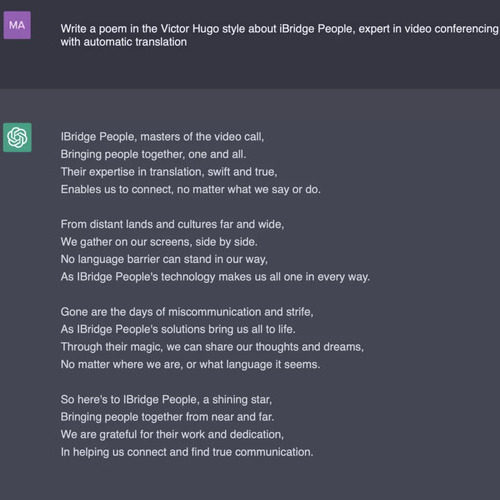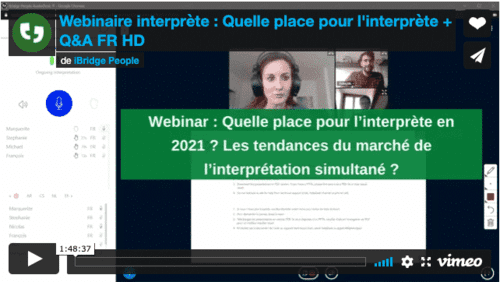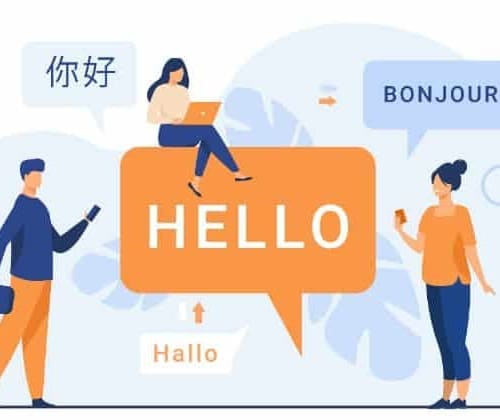The Nuremberg Trials, held by the military tribunals in 1945, are often equated with the advent of conference interpretation as it is practised today.
In fact, there is still some confusion between consecutive and simultaneous interpretation at international conferences and multilingual meetings.
In this article, we will give you some historical background to better understand the fundamental differences between the forms of conference interpretation as we know them today.
The Peace Conference in 1919 marked the beginning of the golden age of consecutive interpretation
The 1919 Paris Peace Conference
This conference was a turning point for two reasons; the first was that it marked the beginning of the end of the French language as a diplomatic language. For French had been a device in the shaping of international relations. Indeed, from the 18th century onwards, the French language replaced Latin in the drafting of international treaties. The predominant use of English at the 1919 Peace Conference thus demonstrates the growing political weight of Great Britain and the United States.
The second reason is that the need for interpretation was clearly demonstrated at the conference, as interpretation was not a regulated profession at the time. Thus, “intelligent people with no other guide than common sense and practice” were used. Interpreters were chosen for their knowledge of languages and cultures; they learned to interpret “on the job” on the basis of a university degree. Some of the interpreters present at the Peace Conference were chosen because they had already done similar work during the First World War, which earned them respect and indulgence during the event. Among them were Gustave Camerlynck, Léon Dostert, Jean Herbert and the most gifted: Paul Mantoux, an example to his peers.
Initially, the long consecutive method was the preferred method of interpretation during the Paris Conference. It consisted of taking notes, on the basis of which the minutes were generally drawn up.
The short consecutive method, without taking notes, was used for sight translation of documents during the successive sessions. The chuchotage method was used to translate the words of the speakers in the commissions.
The first lines of definition of the interpreter’s profession appeared at the Paris Conference of 1919, since it was then that various ethical questions began to be asked about this status, which was little known at the time. Did an interpreter have the ability to nuance the original words or could he or she modify the original register? It was naturally expected that the interpreter would not exceed the speaker’s speaking time, without considering how much time was needed to listen and translate at the same time. The interpreters of the time could not rely on a technical environment to guarantee an ideal transcription of their translation, and the acoustics in particular were not in their favour.
In the rest of this article, we will therefore look at the stages the sector has gone through, starting with the golden age of consecutive interpreting and ending with the birth of simultaneous interpreting.
The golden age of consecutive interpreting
During the inter-war period, the need for interpretation continued to increase at the League of Nations, which became the United Nations. Freelancers were therefore called in as reinforcements, which was a great novelty for the time.
In this context, there was no specialised interpreter training yet, the community thought that interpreting skills were innate. So interpreters came from all walks of life: academics or foreign affairs officials. Most were men, from the European upper middle class. They wanted to enter the profession of interpreter, which was considered superior to the profession of translator, although the entrance exam to the League of Nations was the same for both professions.
Jesus Baigorri, an interpreter who has worked in the field for the United Nations and teaches at the University of Salamanca, clarifies this dichotomy in the perception of this activity. In fact, the profession of interpreter requires a great deal of rigour in the knowledge of protocol and a solid general culture, as well as mastery of the art of oratory, frequent travel and working with respected figures. As a result, interpreting began to attract a lot of interest from people in the field, which naturally led to higher salaries and better working conditions.
As the need for interpreters grew, so did the number of international meetings. In this sense, the first school of interpreters was founded in Geneva by Antoine Velleman in response to the creation of new international bodies such as the Permanent Court of International Justice and the Red Cross.
During the golden age of consecutive interpreting, each interpreter practised his or her own method; some took notes while others relied solely on their memory. However, multilingual consecutive interpreting made the task more difficult and more efficient methods had to be introduced. This was the starting point for the first technical trials to facilitate simultaneous interpretation, which gave rise to the modern simultaneous interpretation system during the Nuremberg trials.
Improved technology supports simultaneous interpretation
Interpreters’ distrust of technical progress
At that time, technical innovation was seen as a threat. For professional interpreters, the advent of simultaneous interpreting meant the disappearance of a certain fascination for the profession, if not its total dissolution.
However, the main problem with consecutive interpreting could not be denied: the lack of spontaneity in the discussions and the lengthening of the exchanges. In order to overcome this problem, the Boston businessman Edward Filene undertook to present a revolutionary idea to the inventors of the time, such as Thomas Edison and Cardy. The project was finally entrusted to Gordon Finlay, who was the first to test the simultaneous technique in a laboratory designed for this purpose in order to interpret shorthand notes. The problem was that one interpreter could not read notes taken by another. Despite the inconclusive initial trials, the results of the experiment show the technical details necessary for good simultaneous interpretation.
Boston Edward Filene therefore invested in optimising the process so that the system could be adopted permanently at the ILO in 1928. The main advantages highlighted were the time and cost savings associated with the use of simultaneous interpretation.
From this experience came important prerogatives for the interpreting world:
- Prefer to work for a maximum of half an hour at a time for each interpreter
- Provide a minimum of two interpreters for a meeting or conference to allow each interpreter to alternate and rest for the duration of the event
- Having the texts available in advance to allow each interpreter to carry out preliminary and additional research on which to base their work
- This new technology has also opened up work opportunities for interpreters from all over the world, who are now judged more on their interpreting skills than on their social background.
The transition from consecutive to simultaneous interpretation at the Nuremberg trial
It was not thought at the time that interpreters could listen and speak at the same time… And yet!
At the Nuremberg trial, the defendants, witnesses and members of the Tribunal did not necessarily all speak the same language, nor were they polyglot. They had to be able to communicate easily and quickly.
In this exercise, the difficulties were as much technical, linked to the adoption of Filene-Finlay equipment acquired by IBM, as they were human. Indeed, many interpreters were reluctant to work with this process, which was unknown to them until then. Most of them were already working for international organisations and did not want to sacrifice a stable full-time job, let alone go and live in a city completely destroyed by the war.
It was therefore up to the delegations of the Military Tribunal to find candidates with very little experience. Moreover, as time was short, the new recruits were given virtually no pre-trial training. Faced with the historical stakes of this event, the interpreters once again learned “on the job” and only the best were able to stand out. In view of all these factors, as well as the poor soundproofing of the booths and the mediocre quality of the acoustics, they benefited from the tolerance of the diplomats who perceived the work of an interpreter in these conditions as a feat.
In summary
The interpreting profession has been slow to define its contours. Indeed, it has gone through many practical and technical experiments before its indispensability was established at conferences around the world, at international meetings, and at physical and digital events.
At the 1919 Paris conference, it was the long consecutive with note-taking that played a major role in the development of interpretation methods. This method consists of letting the speaker speak for a long time, while taking notes so as to remember the speech and transcribe it in the most appropriate way.
During the Nuremberg trials in 1945-46, simultaneous interpretation was seen as an indispensable alternative to consecutive interpretation, as it facilitated the work of the interpreters and reduced the length of the proceedings, while allowing more spontaneous communication between participants who spoke different languages. Although the technical and human conditions were difficult at the time, the introduction of simultaneous interpreting was a great success in terms of saving time and money.
Please feel free to send us your questions and comments to ibp@ibridgepeople.com
—————
Source :
- Baigorri Jalón, J. (2004) : From Paris to Nuremberg: The Birth of Conference Interpreting, translated from the Spanish and edited by Clara Foz, Ottawa, University of Ottawa Press, 289 p.








